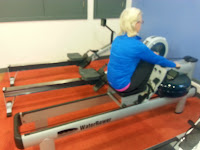Ingredients
 375g salmon fillet
375g salmon fillet200mls milk
500g potatoes, peeled and chopped (I actually used both king Edwards and a sweet potato, worked just as well)
half teaspoon cumin seeds (I didn't use on this occasion)
4 tablespoons olive oil (I used half extra virgin olive oil and half coconut oil)
4 spring onions, finely sliced
1 tablespoon chives, chopped
1 egg, beaten
2 slices Burgen Buckwheat & Poppy seed bread, made into fine breadcrumbs (I used Burgen Sunflower & Chia Seeded bread)
2 red peppers, de-seeded and halved
4 eggs poached
Method
- Steam the salmon in tin foil for 3 - 5 minutes or until cooked through. Break the fillet into medium flakes and remove any skin or bones.
- Next boil the potatoes until tender, drain and mash. Keep warm.
- Meanwhile, heat a teaspoon of oil and fry the cumin seeds and spring onions for 2 - 3 minutes.
- Now add the fish, chopped chives and spring onion mix to the potatoes. Season with a little salt and pepper. When cool enough to handle, shape into 4 fishcakes.
- Next dip the fishcakes into the whisked egg then breadcrumbs. Leave to rest in the fridge for 10 - 15 minutes.
- While the fishcakes are resting make the red pepper sauce. Grill the red peppers until charred then place in a food bag such as a freezer bag or wrap in cling film. Leave for a few minutes, this hopefully will allow you to peel off the charred skin (warning be patient, to be honest I struggled with this a little but it was worth it!). Blend the remaining pepper flesh for a smooth sauce consistency to your liking. But aside till ready to serve.
- Heat the remaining oil and cook the fish cakes for 4 - 6 minutes each side. Serve with the red pepper sauce and top with a soft boiled poach egg. I also served mine with some broccoli. But would work well with a light fresh salad on the side for lunch or a different green vegetable such as asparagus.
Scrummy - ENJOY :)
www.mw-pt.co.uk
STOP PRESS - FEBRUARY OFFER - BUY MY BRONZE PACKAGE (BUY 8 GET 2 FREE) FOR £280
NORMALLY £320!!





